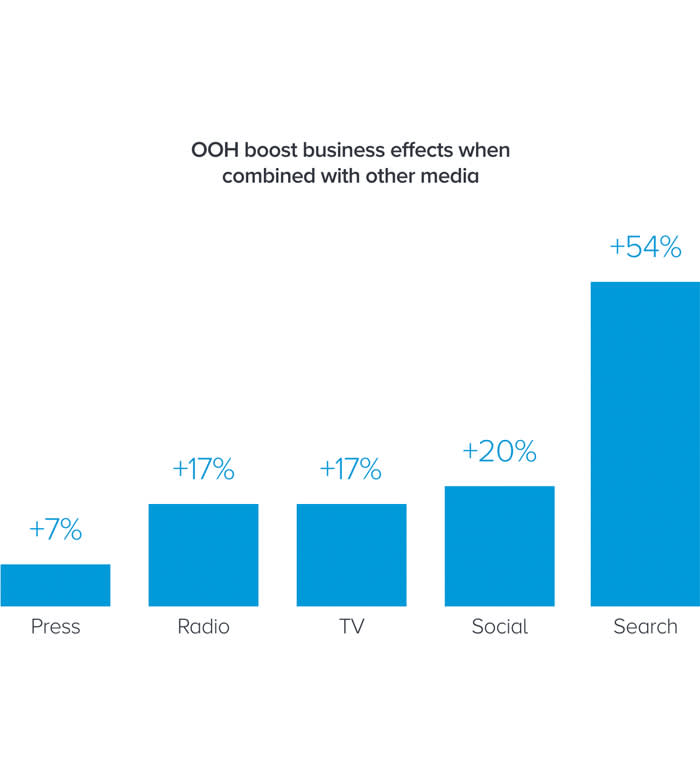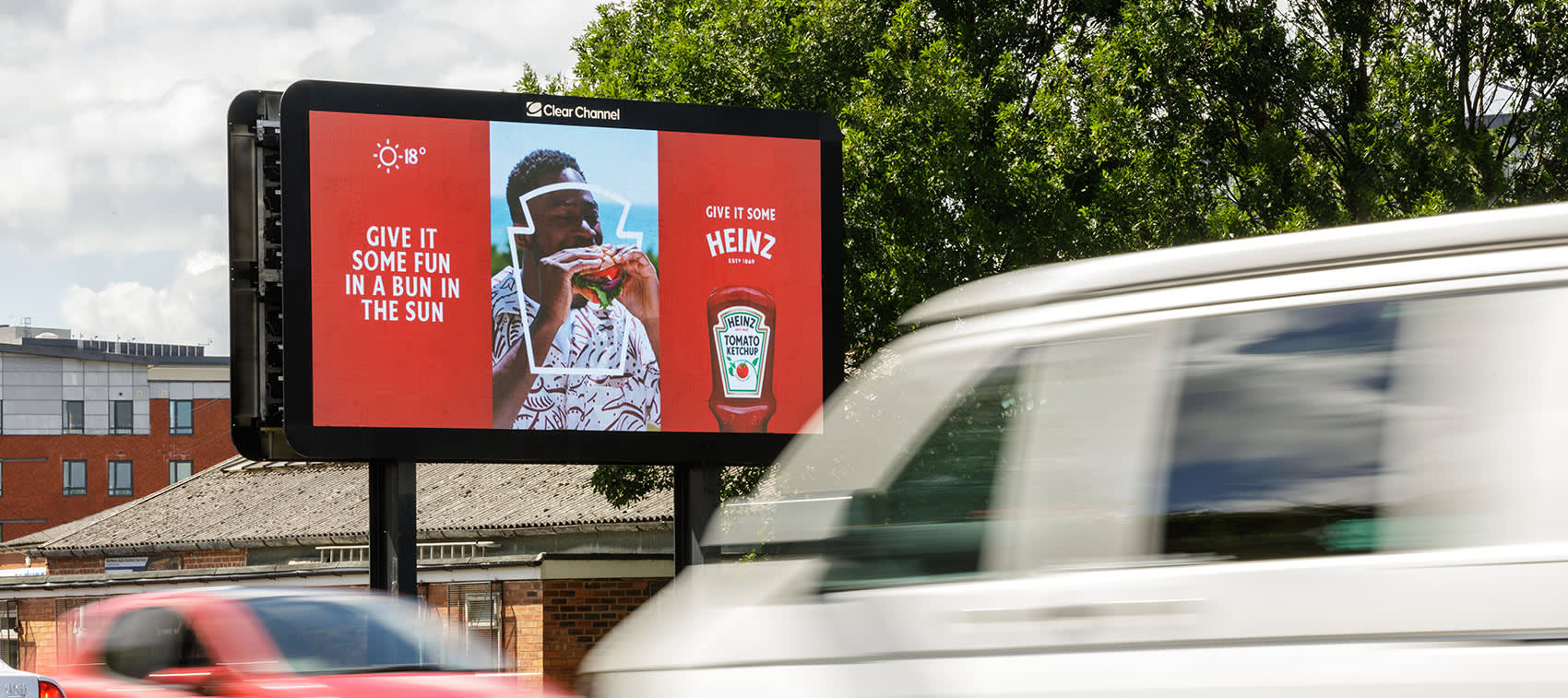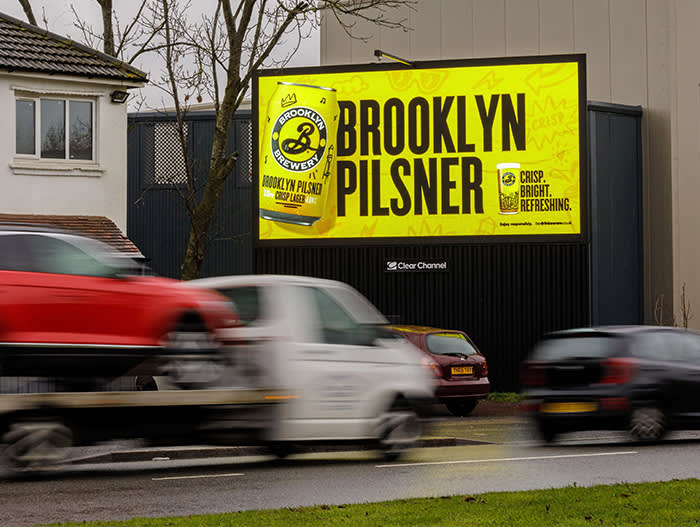Programmatic Out of Home advertising is a rapidly growing media channel, and an important part of an omnichannel marketer's toolkit. This page provides a brief introduction specifically to programmatic, but if you’re interested in finding out more about our brilliant medium and how it can help your brand, you might also like the content on Why Out of Home?; what is digital Out of Home?; why now is The Moment for Trust; and if you’re already familiar with programmatic OOH and are looking at Bauer Media Outdoor’s approach, check out the tech advertising buying platform – LaunchPAD.
What is programmatic OOH advertising?
Before you understand programmatic Out of Home, you need to understand programmatic advertising.
Put simply, programmatic advertising is the automated buying and selling of ad inventory using technology and software – a supply-side platform (SSP) selling space from media owners, connected to a demand-side platform (DSP) buying advertising from brands and agencies. ~70% of online media budgets are now traded programmatically.
The platforms aggregate all the data from both sell and buy sides to efficiently buy the most relevant advertising plays for the brand, based on the audience and campaign parameters they’re looking for, in near-real time.
With the rapid growth of digital Out of Home (DOOH), now reaching 70% of UK adults weekly, the channel is quickly moving into an automated world, with data dictating not just what brands buy, but when, where and how.
This makes programmatic Out of Home the automated buying of audience impressions across DOOH formats. Below is an exploration of the differences between programmatic online and programmatic OOH, the reasons they’re complementary channels as part of an omnichannel advertising strategy and a look at how marketers and brands can activate campaigns as part of their campaign.
Sources: Magna Global December 2021; Zenith Programmatic Marketing Forecasts 2019 (Global)
Programmatic Advertising: Online vs. Out of Home
When it comes to programmatic, Out of Home and online are very different channels.
The two most critical differences are a. that online is a one-to-one medium, delivering only one advertising impression per play, while Out of Home is a one-to-many medium that delivers multiple advertising impressions per play; and b. the context in which they’re consumed – OOH is a physical, public, real-world channel vs. online, which is a private communication mostly delivered with the context of the content around which the ad is displayed.

Complementary channels
There is significant evidence pointing to the benefits of an integrated, omnichannel advertising strategy.
Out of Home is proven to prime and boost other channels. Programmatic DOOH offers the unprecedented opportunity for digital buyers to seamlessly reach customers when they are both online and offline.
Industry research, The Cookieless Future, shows the priming effect of outdoor shows a 36% increase in attention paid to online ads when primed using OOH, alongside a 67% increase in cookie-less click-throughs when an online campaign is supported by outdoor.
Sightline’s DOOH Difference 2022, notes that DOOH encourages 66% more people to search online, and 50% of people to make online purchases. And;
Posterscope Effectiveness Database, 2016-2020, showed consumers who see out-of-home (OOH) advertising are 63% more likely to take an online brand action.
Data and measurement in programmatic OOH
Audience measurement
When buying programmatically, advertisers are buying audiences.
Out of Home’s audience data in the UK is a Joint Industry Currency, Route Research, which calculates audience impressions based not only on people exposed to Out of Home locations, but also on supplementary eye-tracking work giving a robust understanding of who actually sees the ads.
As programmatic OOH is a one-to-many medium that delivers multiple advertising impressions per play, meaning a single ad play reaches multiple people, audience delivery on an individual Out of Home ad play can vary by screen, location and time. At the time of buying a campaign, an impression multiplier is used to communicate the total number of impressions per play based on the parameters of screens, locations and times.
Enhanced planning insights
It’s commonplace to buy online and mobile ads programmatically based on target audiences. This opportunity is available for DOOH, using advanced audience targeting techniques.
Bauer Media Outdoor uses a suite of insight and smart planning tools, allowing brands to target audience cohorts at each stage in the consumer journey through demographic, socio-economic, behavioural, purchasing and affinity data.
The insight generated can supplement first-party brand data select the best inventory to be made available for each programmatic deal to deliver more effective and targeted campaigns. The possibility to target both diverse and segmented audiences can bring greater ROI to your advertising spend.

Data and trigger-based buying
Unlike traditional and digital Out of Home, programmatic gives advertisers an increased level of control and flexibility when it comes to buying campaigns, akin to the capabilities of digital programmatic.
Using foundational data, that is known and consistent, such as day, time and location or variable data, which is unknown and uncontrollable, such as the weather, sports results or user behaviour, advertisers can activate programmatic DOOH campaigns at the most relevant moment for the campaign.
With insight from a campaign strategy, activating DOOH at the right moment can deliver additional visibility on your campaign at the most effective time. Setting parameters in the programmatic buying platform will activate a campaign only when those conditions are met.
Dynamic creative optimisation
Our industry research, The Moments of Truth, demonstrates the benefits of making creative copy as relevant as possible to the audience.
Explicitly referencing relevant content or moments on the creative, as well as displaying the campaign at the most relevant time, significantly increases a brain response in audiences engaging with Out of Home.
Brands can leverage advanced audience, asset and environmental data to drive maximum contextual relevance by dynamically serving ads based on the data associated with each play, and on an advertisers campaign requirements.
OOH vs DOOH vs PrOOH?
What are the similarities and differences between traditional, digital and programmatic OOH?
| Audience targeting | Creative capabilities | Cost efficiency | Booking lead time | Campaign reporting | |
|---|---|---|---|---|---|
| Traditional Out of Home | One-to-many Mass reach Geo-targeting desired audiences or locations | Ads printed and posted Special physical printing and creative opportunities | Efficient cost per impression Sites purchased individually or in networks | Lead time typically 1-week Ads can run in set “posting” periods | Assets/locations supplied to advertisers Proof of Posting (POP) Campaign photography provided |
| Digital Out of Home | One-to-many Mass reach Geo-targeting desired audiences or locations | Dynamic ad changes Update creative in real time to respond to triggers as data feeds, current events or social inputs | Efficient cost per impression Screens purchased individually or in networks | Lead time in hours Unlimited ad posting periods | Asset/locations supplied to advertisers Additional insights and analytics via play-based data Camping Photography provided |
| Programmatic Out of Home | One-to-many Mass reach & Hyper Targeted Advanced data targeting | Unlimited number of ad changes Greatest level of control for advertisers | Higher cost per impression, more targeted campaigns Bought based on impressions via a DSP Traded on cost-per-thousand (CPM) | Lead time in near-real time Unlimited ad posting periods Ultimate campaign flexibility | Detailed reportage capabilities via DSP, including locations, impressions, bid requests and more |
Buying OOH from all channels provides:
Audience targeting
Both approaches help advertisers reach the right consumer at the right time, based on audience segments, proximity to key locations, specific neighborhoods, and other key demographic characteristics.
Dynamic creative
Variable messaging is a crucial differentiator for CCE’s programmatic and direct offerings. Updates to messaging can adjust dynamically based on the time of day, the day of the week, the temperature, the traffic speed, and more.
Measurability
OOH is measurable, just like other media. With CCE’s suite of data-driven solutions, we can help advertisers plan, amplify, and measure their OOH campaigns.
Data-informed insights
Campaigns can leverage data to change messaging through both approaches dynamically. However, the inventory is locked with a direct buy and the data-informed messaging plays throughout the pre-sold campaign. With a programmatic buy, data informs the dynamic message and determines whether the ad is served.
What to know about programmatic OOH

A recent industry study, “Programmatic DOOH: The time is now” from JCDecaux, demonstrated how programmatic Out of Home is quickly becoming a part of the mix for programmatic marketers, with 54% of buyers saying they are always involved in the planning and buying of at least one other digital channel. Programmatic OOH buyers sit within integrated omnichannel teams.
For brands already using an omnichannel DSP, there is now easy access to add DOOH to existing digital and video campaigns. With 8 Bauer Media Outdoor Europe markets now connected to multiple DSPs, there are excellent opportunities to activate multi-market campaigns with complete control over display on specific days, times and messaging. And it’s a perfect choice for advertisers and agencies looking for self-serve options, for mid-flight adjustments to budgets, audiences-targeting, dayparting and creative through the DSP.

One in three digital marketers surveyed said that programmatic Out of Home can deliver both brand and performance KPIs, topping a list of 13 media channels, showing it’s full funnel potential, with two in three saying they measure online sales to analyse campaign performance. The study also showed the desire of marketers using programmatic Out of Home to use more and new OOH environments as they become available through their DSP.
In 2022, Bauer Media Outdoor’s DOOH impressions doubled, to over 1bn, and the brand count of advertisers buying programmatically has grown by more than 100, from existing Out of Home buyers complementing digital plans at key brand moments, to new digital-native brands dipping their toes into DOOH for the first time.
How to buy programmatic OOH
Step 1
Briefing
Campaign briefing should include the following details:
Client
Agency (if applicable)
Campaign/brand name
Period
Advertising medium/channel
Geo targeting
Time targeting
Impressions
(if available)Budget
Step 2
Check and deal ID
Programmatic Team confirms deal feasibility.
One or more deals will be created on the SSP based on the CPM and impressions agreed.
The customer will be provided with one or more deal IDs, in order to activate the campaign.
Step 3
Campaign set-up
Once the deal ID is received, the customer can set up the campaign
with the deal ID on the DSP page.
Step 4
Technical specifications and uploading of creatives
The advertising media must comply with the technical specifications and restrictions applicable. Creatives must be uploaded to the DSP. Bauer Media Outdoor will review the creatives, and approve or reject accordingly.
Step 5
Live
The campaign is live. Depending on the deal type, the customer can actively intervene in the campaign performance.
Reporting is available in the DSP.
Ready for launch?
If you’re interested in finding out more about programmatic OOH, and LaunchPAD, fill in the form to get our latest programmatic research delivered right to your inbox and chat to one of our programmatic specialists.




